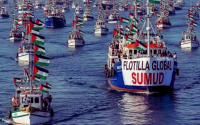February 9 2011
“In memoriam, Christoph Probst, Hans Scholl, Sophie Scholl” reads the banner at the top of Kareem Amer’s popular Egyptian dissident blog. “Beheaded on Feb. 22, 1943, for daring to say no to Hitler, and yes to freedom and justice for all.” The young blogger’s banner recalls the courageous group of anti-Nazi pamphleteers who called themselves the White Rose Collective. They secretly produced and distributed six pamphlets denouncing Nazi atrocities, proclaiming, in one, “We will not be silent.” Sophie and her brother Hans Scholl were captured by the Nazis, tried, convicted and beheaded.
Kareem Amer, who spent four years in prison in Egypt for his blogging, has disappeared off the streets of Cairo after leaving Tahrir Square with a friend, according to cyberdissidents.org. The group assumes Amer is now among the hundreds of journalists and human rights activists snatched by the regime of Egyptian dictator Hosni Mubarak, and has launched a campaign to demand his release.
Amer disappeared just before Wael Ghonim was released. Ghonim is a 30-year-old Google executive who helped administer a Facebook page instrumental to organizing the Jan. 25 protests in Egypt. The page, called “We are all Khaled Said,” is named in memory of a young man killed by police in Alexandria in June 2010. A photo of Khaled Said’s corpse appeared on the Internet, his face savagely beaten. Ghonim traveled to Egypt to participate in the protests, and was arrested and secretly held by the Egyptian government for 12 days. He was interviewed on Egyptian TV channel Dream 2 upon his release. He broke down and cried on camera when shown the photos of many who had been killed so far in the protests. Ghonim said: “I’m not a hero. I was only using the keyboard, on the Internet. I never put my life in danger. The real heroes are the ones on the ground.”
Ghonim’s release swelled the crowds in Tahrir Square, still demanding an end to Mubarak’s 30-year regime. Tahrir, which means “liberation” in Arabic, is the heart and soul of the pro-democracy movement in Egypt, but it is not the only place where spirited, defiant people gather. As this is written, a new encampment is being established outside the Egyptian Parliament. Six thousand workers are reportedly striking at the Suez Canal. As the entrenched dictatorship claimed to be making concessions, its shock troops unleashed a wave of violence, intimidation, arrest and murder.
Egypt’s burgeoning youth population is driving the revolution. The April 6 Youth Movement was formed last year to support textile strikers in the Egyptian city of Mahalla. One of the founders of the movement, Asmaa Mahfouz, who has just turned 26, posted a video to Facebook Jan. 18, days after the Tunisian revolution forced the ouster of that country’s dictator. She said:
“Four Egyptians have set themselves on fire to protest humiliation and hunger and poverty and degradation they had to live with for 30 years. Four Egyptians have set themselves on fire thinking maybe we can have a revolution like Tunisia, maybe we can have freedom, justice, honor and human dignity…. I’m making this video to give you one simple message: We want to go down to Tahrir Square on Jan. 25. If we still have honor and want to live in dignity on this land, we have to go down on Jan. 25.”
Her call to action was another spark. From the Internet, people began organizing in the neighborhoods, bridging the digital divide with printed fliers and word of mouth. Following Jan. 25, the epic first day of protest, she posted another video message: “What we learned yesterday is that power belongs to the people, not to the thugs. Power is in unity, not in division. Yesterday, we truly lived the best moments of our lives.”
The first week of protests breached what many are calling “the fear barrier.” Since the government-backed violence of Jan. 28, according to Human Rights Watch, at least 302 people have been killed in the cities of Cairo, Alexandria and Suez.
President Barack Obama continues to insist that the U.S. can’t choose the leader of Egypt, but that the people of Egypt must. That is true. But the Obama administration continues to supply the Mubarak regime with economic and military aid. The “Made in U.S.A” stamped on the tear gas canisters used against protesters in Tahrir Square enraged the people there. In the past 30 years, the U.S. has spent tens of billions of dollars to shore up the Mubarak regime. It is time to turn off the cash and weapons spigot now.
Denis Moynihan contributed research to this column.






